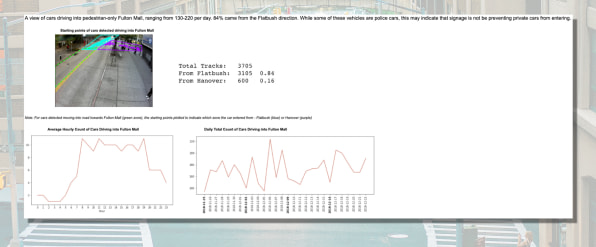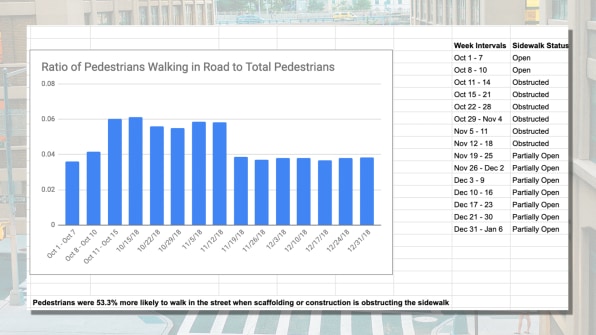[Photo: Dan Gold/Unsplash]
BY EILLIE ANZILOTTI 4 MINUTE READ
Source: fastcompany.com, March 2019
The issue with “smart cities” technology is that it can’t be proven useful until it gets up and running in the urban landscape. The tech hub New Lab gave three startups a chance to prove themselves in Downtown Brooklyn–and it’s paying dividends.
In Downtown Brooklyn, Fulton Street–the neighborhood’s commercial thoroughfare–is restricted to cars. Technically, at least. Fulton is designated as a bus-priority street, but around 3,000 cars each month use the corridor when they’re not supposed to. This creates issues for the buses and their 20,000 daily riders, which rely on clear lanes to make up time on their otherwise crowded routes, and for the pedestrians and cyclists that also depend on the road being car-free for a safer trip.
The Downtown Brooklyn Partnership, a nonprofit that supports local development, has wanted to end to illegal car traffic on the street for a while. But they didn’t know where it was coming from. They suspected cars from smaller side streets were turning onto Fulton. Recently, they learned they were wrong: Around 84% of illegal cars were coming off Flatbush Avenue, the busy arterial road that bisects Fulton. Knowing that, DBP may begin to explore with the city the possibility of implementing new signage and more strictly monitoring the intersection to make sure the street stays car-free.

Data from a startup called Numina was how DBP learned where to focus the city’s car-stopping effort. Numina uses sensors to measure all objects in the streetscape and how they interact with one another. Their lightpole-mounted cameras capture cars, pedestrians, cyclists, and buses (but also trash bags, street furniture, strollers, and more). They detect where and how many of these different objects are moving throughout the cityscape without raising the surveillance questions that usually come with sensor-based technology: Numina does not use facial recognition or license-plate detection tech. It’s just looking for objects and patterns.
When urban tech works, like Numina did for DBP, it can quickly create tangible change in cities. While urban tech is a booming category–AngelList counts over 500 startups in the U.S.–companies often struggle to prove themselves. Unlike social media or data privacy companies, which can run pilots through digital channels, urban tech startups actually need to embed themselves in the urban landscape to prove that they’re viable. Getting buy-in from cities to run urban tech pilots can be a struggle.
New Lab, a Brooklyn-based tech hub that opened in 2016 to help startups grow, recognized that challenge. New Lab’s idea was to source a small cohort of urban tech companies from the startups it works with, and set them up with a pilot in a single neighborhood: Downtown Brooklyn. That way, the city could get a sense of what their technology could do, and the startups could prove that their model is viable. “Urban tech companies need real pilot opportunities to help prove out their products, and for that to matter, they have to be in real urban environments,” says Shaina Horowitz, New Lab’s Urban Tech Hub director. “And for that to work, we need stakeholders at the table: city leaders, agencies, and local businesses.”

The initiative, called The Circular City, tackles those needs. New Lab selected three urban tech startups to participate, and brought them into discussion with local leaders like Brooklyn Borough President Eric Adams, and entities like DBP and the New York Economic Development Corporation. Getting local and industry leaders on board and aware of what the startups aimed to do “deflates some of the fears that exist around what it takes to roll out new tech in a city,” Horowitz says. The six-month pilot run, in which everyone potentially affected by the startups’ presence was aware of what they were doing and able to offer feedback–or draw useful information from the technology–made it easier for city leaders to see how the tech could actually be an asset.
The three startups each brought slight different capabilities to the city. Numina used its sensor tech not only to track illegal car traffic on Fulton, but to examine how construction scaffolding causes pedestrians to change their walking path, and sometimes forces them to walk into the street. CARMERA, another startup that uses sensors embedded in vehicles to gather data for autonomous vehicles, delivered information on street density, and where cars narrowly missed crashes with pedestrians and cyclists. CARMERA’s data, combined with Numina’s, should help inform the city as it tries to figure out where to install street safety measures like crosswalks and bike lanes.
The third startup, Citiesense, doesn’t create data, but rather aggregates it. Citesense’s platform captures everything that exists on the street, from food vendors and bike racks to restaurants and new construction. Founder Starling Childs says Citiesense will integrate data from Numina and CARMERA so neighborhood groups can visualize traffic flows on their streets and sidewalks. That might help a neighborhood like Downtown Brooklyn realize they don’t have enough bike racks to accommodate the number of cyclists ending their journeys there.
The whole point of The Circular City initiative, which will continue to develop after this first trial run, is to bring urban tech and the data it works with out of the theoretical and into the hands of people who can actually use it to change cities for the better. Pedestrian counts and traffic-pattern imaging mean little unless a city agency can use that information as leverage to design safe-street interventions at dangerous intersections, or ensure that people are passing the amenities they need as they walk down a street, and urban tech might stand a chance at relevance.

